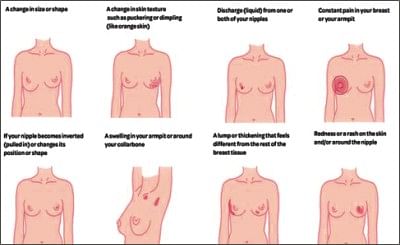Know the alarming changes of breast

Breasts change constantly throughout the life from puberty, through adolescence, the childbearing years, and after the menopause. Some changes are considered normal whether some may be a sign of diseases. Knowing the sign can help you from distinguishing between diseases and normal one. Here are some points noted to illustrate the changes — normal and abnormal.
Before a period
From puberty onwards female hormone named oestrogen and progesterone are responsible for the changes you may notice in your breasts just before your period. The breasts may feel heavier and fuller. They may also be tender or lumpy. After a period this lumpiness becomes less obvious or may disappear altogether, although some women have tender, lumpy breasts all the time. Many women also have breast pain linked to their menstrual cycle (cyclical breast pain).
Breast changes can be an early sign of being pregnant. Many women feel a change in sensation in their breasts such as tingling and soreness (particularly of the nipples). This is due to increased levels of progesterone and the growth of the milk ducts.
When breastfeeding
Large amount of milk are produced to breastfeed a newborn baby, and the breasts can change size many times a day according to the baby's feeding pattern. Nipples can sometimes become sore and cracked, but this generally gets better over time. When breastfeeding stops, the breasts gradually go back to how they were before pregnancy, although they may be of different size and less firm than before.
The alarming changes
These are the changes to every woman should look for and if there is in any doubt, get medical advice:
* A lump or thickening which is different to the rest of the breast tissue
* Continuous pain in one part of the breast or armpit
* One breast becomes larger or lower
* A nipple becomes inverted or changes shape or position
* Skin changes including puckering or dimpling
* Swelling under the armpit or around the collarbone
* A rash on or around the nipple
* Discharge from one or both nipples
The writer is Lead Breast Surgeon at United Hospital, Dhaka. She is also the member of British Association of Surgical Oncology (BASO) and Association of Breast Surgeons of Britain (ABS). E-mail: [email protected]

 For all latest news, follow The Daily Star's Google News channel.
For all latest news, follow The Daily Star's Google News channel. 



Comments